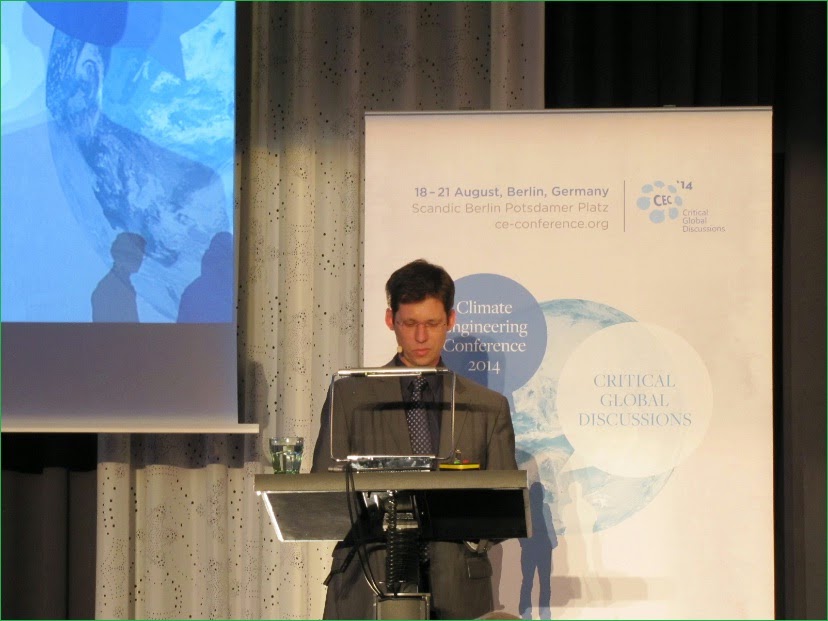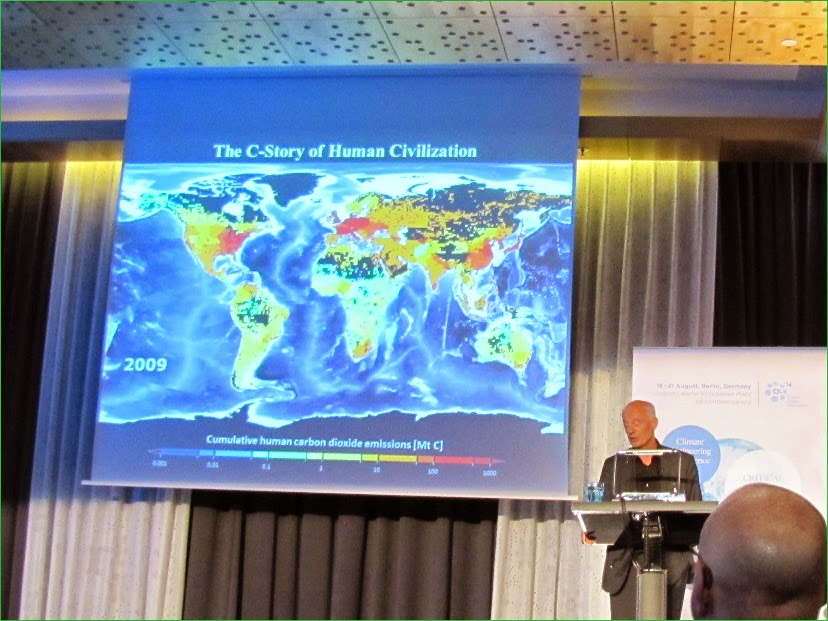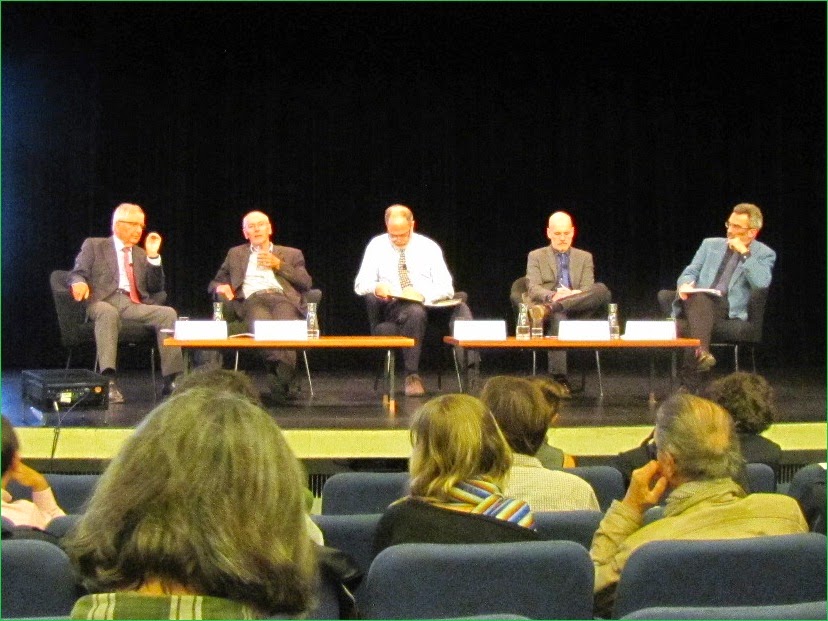CLASH OF THE GEOENGINEERING TITANS
“…The planet is no longer a patient observer and victim of human intervention. It is now a raging beast that we continue to poke. And geoengineering might well be regarded as poking it even more…” – That was one of the conclusions of the first international Climate Engineering Conference (CEC 2014) that took place on October, 18 – 21, 2014, in Berlin under the topic “Critical Global Discussions”. The speakers and participants of the conference included such prominent scientists, economists, politicians, and writers, as Prof. Dr. Mark Lawrence, Dr. Georg Schütte, Prof. Dr. Dr. h. c. Hans Joachim Schellnhuber, Prof. Dr. Dr. h. c. Klaus Töpfer, Dr. Harry Lehmann, Mr. Jamais Casico, Mr. Rene Röspel, Mr. Oliver Morton, and others. I managed to participate in it as ELP alumni with the generous support of IASS Potsdam. The discussions at CEC 2014 were indeed critical considering the controversy around the topic of geoengineering. As the conference website explains, geoengineering, also known as climate engineering, is a combination of “technologies and techniques for intentionally manipulating the global climate, in order to moderate or forestall the (most severe) effects of climate change”. These technologies can be organized into two categories:1. Carbon Dioxide Removal (CDR) that aims to remove carbon dioxide from the atmosphere and includes Carbon Capture and Storage underground facilities, aforestation, ocean fertilization, etc.2. Solar Radiation Management, or Sunlight Reflection Methods (SRM) are methods of minimizing the amount of solar energy and heat reaching the Earth atmosphere by either reflecting sunrays away from the planet by large space mirrors, or dispersing them in the planet’s atmosphere by creating artificial clouds or spreading sulfur dioxide particles in the atmosphere.
The discussions at CEC 2014 were indeed critical considering the controversy around the topic of geoengineering. As the conference website explains, geoengineering, also known as climate engineering, is a combination of “technologies and techniques for intentionally manipulating the global climate, in order to moderate or forestall the (most severe) effects of climate change”. These technologies can be organized into two categories:1. Carbon Dioxide Removal (CDR) that aims to remove carbon dioxide from the atmosphere and includes Carbon Capture and Storage underground facilities, aforestation, ocean fertilization, etc.2. Solar Radiation Management, or Sunlight Reflection Methods (SRM) are methods of minimizing the amount of solar energy and heat reaching the Earth atmosphere by either reflecting sunrays away from the planet by large space mirrors, or dispersing them in the planet’s atmosphere by creating artificial clouds or spreading sulfur dioxide particles in the atmosphere.As one can see, there are rather drastic methods that require enormous investments and influence the climate and hence life all over the globe. Moreover, we still know very little about such technologies and the climatic system they should have effect upon. So, there is much anxiety regarding the potential unforeseen negative consequences and risks associated with geoengineering. And last but not least, it raises a multitude of questions and heated discussions about ethics and equity of experimenting with these technologies, not to mention deploying them.
And this is exactly what happened at CEC 2014. The questions discussed ranged from “What is so special about geoengineering and why should we put so much attention to it?” to “Will the global society be prepared for sudden rise of support for geoengineering due to governmental approval or, let’s say, Rupert Murdoch’s supportive tweet? And what consequences it will bring to the environment and society?”
 Certainly, the participants of the conference included both active supporters of geoengineering and its active opponents. The “clashes of the geoengineering titans” happened mostly around three topics: the possible military use of climate engineering technologies; the potential of experiments with such technologies and their deployment to redirect attention from actual climate change mitigation (that is, prioritizing “treating symptoms” over “fighting the disease”); and the possible and currently unknown consequences of geoengineering on the developing countries (climate equity issue) and the planet as a whole.Right from the beginning of the conference there was even a document, the so-called Berlin Declaration, proposed for participants’ support and signature. This document called upon governments, research funding organizations and scientific and professional bodies to give approval or endorsement of any experiments on geoengineering (especially on SRM) ONLY in case of these experiments having open and transparent review process and the “social licence” necessary for them to operate. However, the conference organizers immediately communicated that the Berlin Declaration is not and will never be an official output of CEC 2014 and that its signing is the personal decision of each participant. During the conference the document had been renamed into A Framework for More Democratic Governance of Climate Engineering, also known as the Scandic Principles, and enriched with the list of risks the geoengineering experiments ought to take account of and a more detailed description of transparency, open governance and other principles to regulate geoengineering technologies. Still, the document remained as an unofficial individual initiative and not the official public output of the event.
Certainly, the participants of the conference included both active supporters of geoengineering and its active opponents. The “clashes of the geoengineering titans” happened mostly around three topics: the possible military use of climate engineering technologies; the potential of experiments with such technologies and their deployment to redirect attention from actual climate change mitigation (that is, prioritizing “treating symptoms” over “fighting the disease”); and the possible and currently unknown consequences of geoengineering on the developing countries (climate equity issue) and the planet as a whole.Right from the beginning of the conference there was even a document, the so-called Berlin Declaration, proposed for participants’ support and signature. This document called upon governments, research funding organizations and scientific and professional bodies to give approval or endorsement of any experiments on geoengineering (especially on SRM) ONLY in case of these experiments having open and transparent review process and the “social licence” necessary for them to operate. However, the conference organizers immediately communicated that the Berlin Declaration is not and will never be an official output of CEC 2014 and that its signing is the personal decision of each participant. During the conference the document had been renamed into A Framework for More Democratic Governance of Climate Engineering, also known as the Scandic Principles, and enriched with the list of risks the geoengineering experiments ought to take account of and a more detailed description of transparency, open governance and other principles to regulate geoengineering technologies. Still, the document remained as an unofficial individual initiative and not the official public output of the event. All in all, the 5-days conference, including its open-for-public panel “The Anthropocene – An Engineered Age?” on October, 22, 2014, at the House of World Cultures in Berlin, concluded that geoengineering must not be a substitute for climate change mitigation and that much care and regulation is needed before we can move forward to large-scale experiments and implementation of these technologies. Still, many questions remained to be discussed and answered. And thus the true “clashes of geoengineering titans” are yet to come.
All in all, the 5-days conference, including its open-for-public panel “The Anthropocene – An Engineered Age?” on October, 22, 2014, at the House of World Cultures in Berlin, concluded that geoengineering must not be a substitute for climate change mitigation and that much care and regulation is needed before we can move forward to large-scale experiments and implementation of these technologies. Still, many questions remained to be discussed and answered. And thus the true “clashes of geoengineering titans” are yet to come.Sursa
2014-08-22 22:28:00

